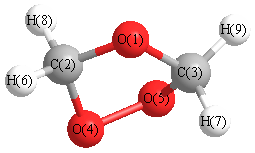Vibrational Frequencies calculated at QCISD/3-21G*
| Mode Number |
Symmetry |
Frequency
(cm-1) |
Scaled Frequency
(cm-1) |
IR Intensities
(km mol-1) |
Raman Act
(Å4/u) |
Dep P |
Dep U |
|---|
| 1 |
A |
3146 |
3024 |
1.17 |
|
|
|
| 2 |
A |
3079 |
2959 |
0.22 |
|
|
|
| 3 |
A |
1600 |
1538 |
0.00 |
|
|
|
| 4 |
A |
1418 |
1363 |
3.07 |
|
|
|
| 5 |
A |
1215 |
1168 |
0.40 |
|
|
|
| 6 |
A |
1127 |
1083 |
1.92 |
|
|
|
| 7 |
A |
985 |
947 |
8.83 |
|
|
|
| 8 |
A |
911 |
875 |
26.42 |
|
|
|
| 9 |
A |
836 |
804 |
17.34 |
|
|
|
| 10 |
A |
704 |
676 |
0.52 |
|
|
|
| 11 |
A |
346 |
332 |
6.55 |
|
|
|
| 12 |
B |
3149 |
3026 |
54.23 |
|
|
|
| 13 |
B |
3075 |
2955 |
80.21 |
|
|
|
| 14 |
B |
1582 |
1520 |
8.34 |
|
|
|
| 15 |
B |
1359 |
1306 |
1.40 |
|
|
|
| 16 |
B |
1192 |
1146 |
1.89 |
|
|
|
| 17 |
B |
1118 |
1075 |
13.64 |
|
|
|
| 18 |
B |
1032 |
991 |
145.05 |
|
|
|
| 19 |
B |
854 |
821 |
1.42 |
|
|
|
| 20 |
B |
648 |
623 |
4.87 |
|
|
|
| 21 |
B |
168 |
161 |
23.66 |
|
|
|
Unscaled Zero Point Vibrational Energy (zpe) 14770.7 cm
-1
Scaled (by 0.9611) Zero Point Vibrational Energy (zpe) 14196.1 cm
-1
See section
III.C.1 List or set vibrational scaling factors
to change the scale factors used here.
See section
III.C.2
Calculate a vibrational scaling factor for a given set of molecules
to determine the least squares best scaling factor.
